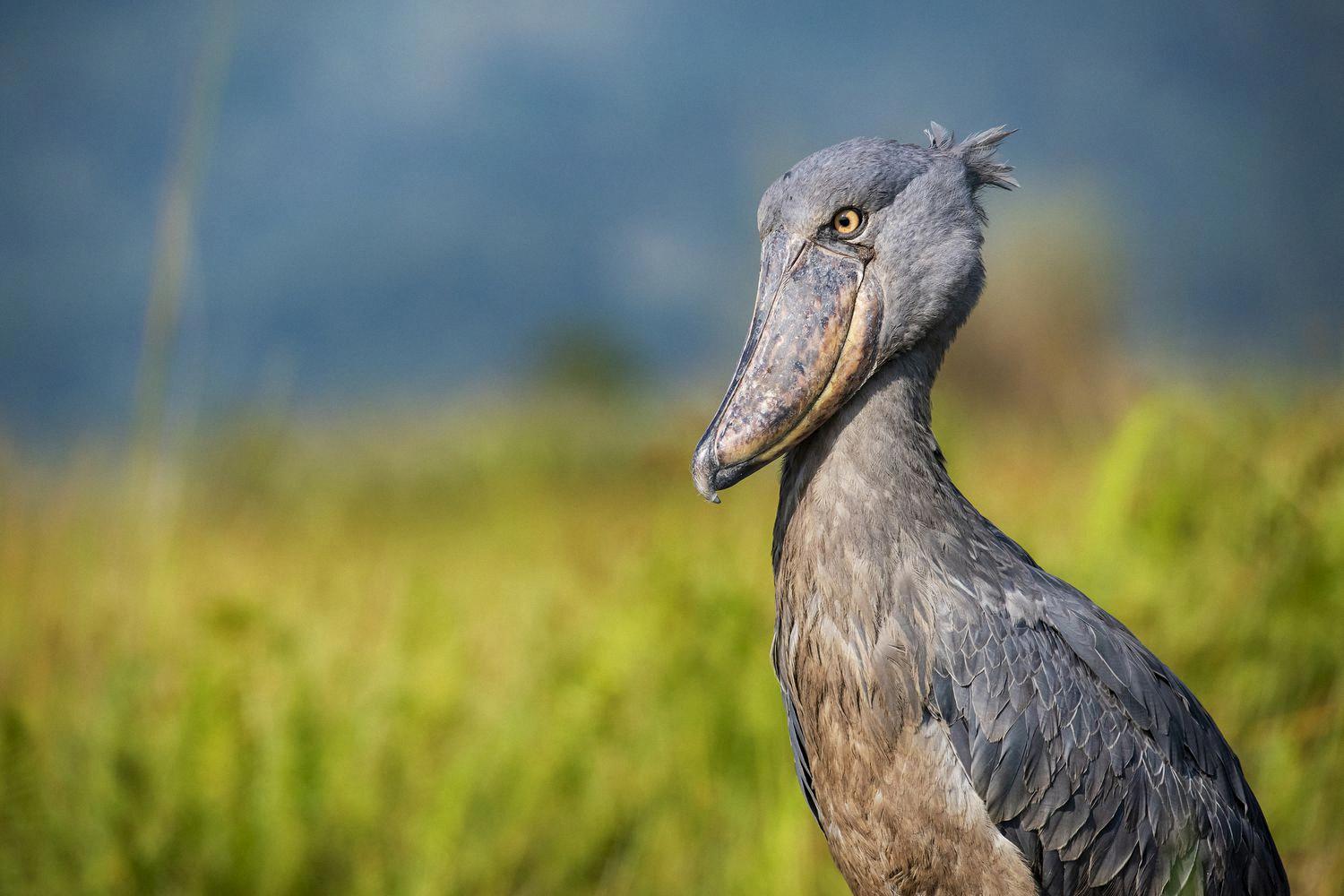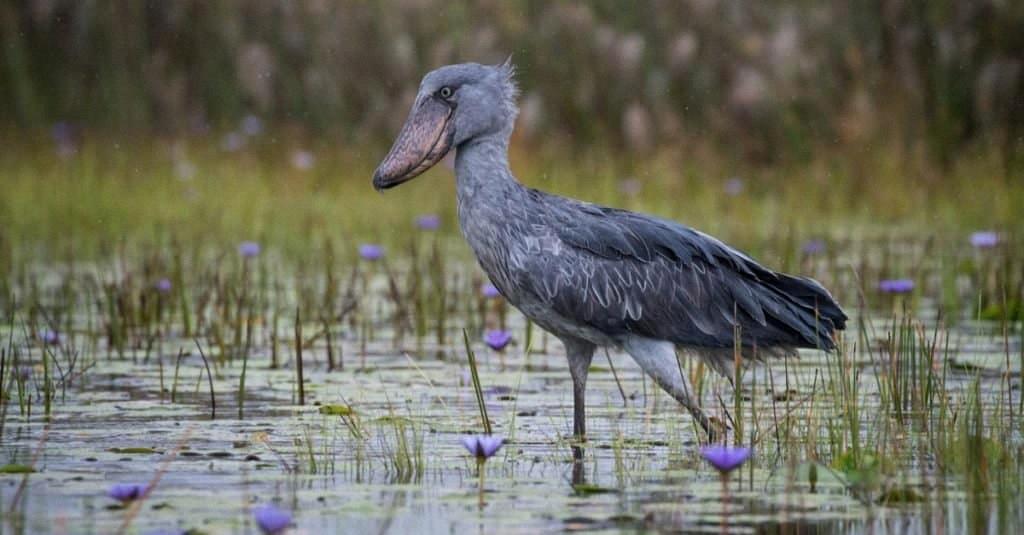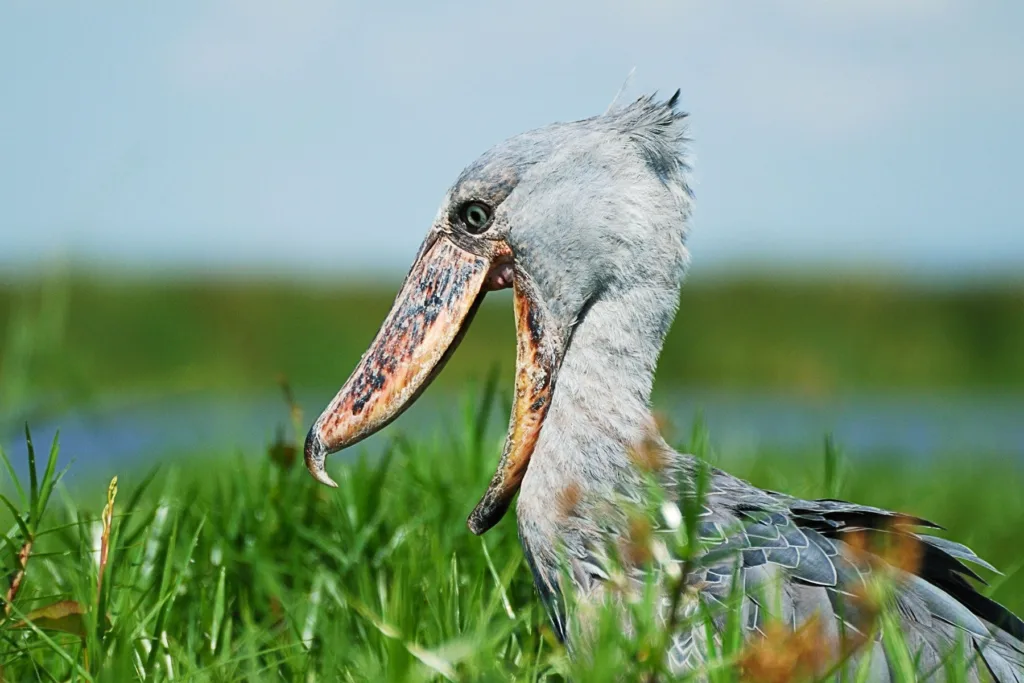The shoebill stork, also known as Balaeniceps rex, is a fascinating bird that is endemic to the swamps and wetlands of Central and East Africa. This giant bird has a large body, huge wings, and a bill that looks like a shoe. It is a formidable predator that feeds on a variety of prey, including fish, frogs, snakes, and even small mammals. However, one of the most interesting questions about the shoebill stork is whether it eats crocodiles.
The answer to this question is not straightforward. While shoebill storks are known to prey on a variety of animals, including small crocodiles, it is unlikely that they would be able to take down a full-grown crocodile. Although shoebill storks are large and powerful birds, they are no match for the strength and agility of a crocodile. Crocodiles are apex predators that have been known to attack and kill animals much larger than the shoebill stork.
However, shoebill storks have been observed eating the eggs and hatchlings of crocodiles. These young crocodiles are much smaller and weaker than their adult counterparts, making them an easier target for the shoebill stork. Shoebill storks have also been observed feeding on the carcasses of dead crocodiles.
It is important to note that shoebill storks are not specialized predators of crocodiles. They are opportunistic feeders that will eat whatever prey is available in their habitat. While they may occasionally prey on young crocodiles or feed on dead crocodiles, this is not a significant part of their diet.
While shoebill storks may eat young crocodiles or feed on the carcasses of dead crocodiles, they are not known to be significant predators of adult crocodiles. These birds are fascinating creatures that play an important role in the ecosystem of the wetlands and swamps of Africa.
Predators of the Shoebill
The shoebill stork, also known as Balaeniceps rex, has few predators due to its large size and impressive beak. Its primary predators are crocodiles, which can attack shoebills in the water or on land. Humans are also a threat to shoebills, as they are sometimes hunted for their meat, feathers, or as trophies. However, due to their rarity and protected status, hunting shoebills is illegal in many countries. Overall, the shoebill stork is a formidable bird that is well-equipped to defend itself against most predators.

Source: treehugger.com
Are Shoebill Storks Aggressive?
Shoebill storks are not known to be aggressive towards humans. In fact, they are quite docile and researchers studying these birds have been able to approach them within 6 feet of their nests without any threat. Shoebill storks are known to stare back at humans who come too close to them, but they do not exhibit any aggressive behavior. However, it is important to note that shoebill storks are wild animals and it is always advisable to maintain a safe distance from them to avoid any potential harm.
Do Shoebills Enjoy Water?
Yes, shoebills are water-loving birds that are commonly found in poorly oxygenated waters like swamps, marshes, and bogs. These birds are known to be attracted to these types of environments because they provde an abundant food source for them, especially fish that frequently surface to breathe. Shoebills have a unique bill structure that enables them to capture and consume larger fish than other birds of their size. Additionally, shoebills exhibit migratory behaviors based on differences in the surface water level, indicating their close association with water. Overall, shoebills have a strong affinity for water and are well-adapted to living in aquatic environments.
Is the Shoebill a Dinosaur?
While the shoebill stork (Balaeniceps rex) is not a dinosaur, it is believed to be related to them. The shoebill’s physical characteristics, such as its large size, broad body, and unique bill shape, are similar to those of some prehistoric birds and dinosaurs. In fact, scientists have identified similarities between the shoebill’s skull structure and that of some theropod dinosaurs, a group that includes the famous Tyrannosaurus rex. While the shoebill stork is not a direct descendant of dinosaurs, it is considered to be an evolutionary link between modern birds and their prehistoric ancestors.
Do Shoebills Engage in Conflict with Crocodiles?
Shoebills are known to be fierce predators that hunt for their food in the swamps and wetlands of Africa. Although they are known to eat smaller crocodiles, they do not usually engage in fights with adult crocodiles. Shoebills are known to be cautious animals and will typically avoid confrontation with larger and more dangerous animals. However, if a shoebill feels threatened or cornered, it may use its powerful beak to defend itself. In summary, while shoebills do not actively seek out fights with crocodiles, they are capable of defending themselves if necessary.

Source: a-z-animals.com
Has a Shoebill Ever Attacked a Human?
There is no record of a shoebill ever attacking a human. These wading birds are not known to be aggressive towards humans and pose no threat to people. While shoebills may look intimidating with their large, sharp beaks and fierce appearance, they are actually vulnerable species that face threats from habitat loss and poaching. Therefore, it is safe to say that people are not at risk of being attacked by shoebills.
Speed of Shoebill Flight
Actually, shoebills are not known for their flying abilities. Despite having large wings, they are not strong fliers and prefer to spend most of their time on the ground or perched in trees. In fact, they are better adapted for walking and wading through swamps and marshlands, where they hunt for prey such as fish, frogs, snakes, and even baby crocodiles. While they may occasionally take short flights to escape danger or move between roosting sites, their top speed is estimated to be only around 35-48 kph (20-30 mph). Overall, shoebills are fascinating birds with unique adaptations for their wetland habitats, but flying is not one of their strong suits.
Can the Shoebill Fly?
Yes, shoebills can fly, although they don’t do so very often or for very long distances. Shoebills are large birds, growing up to 1.5 meters tall and weighing up to 7 kilograms, wich makes flying quite a challenging task. However, shoebills are capable of taking off and flying short distances if they need to, such as to escape danger or to move to a new location. Despite their size, shoebills have strong wings that allow them to lift off the ground and soar through the air. Overall, while shoebills are not known for their flying abilities, they are indeed capable of flight.
Do Shoebills Engage in Combat?
Yes, shoebills are known for their aggressive nature and are not afraid to fight off small and large animals alike. They are brave and will even attack crocodiles if they feel threatened. This behavior is likely due to their territorial nature and their need to protect their nesting sites and food sources. So, in short, shoebills do fight when necessary.
Estimating the Remaining Population of Shoebills
Currently, it is estimated that there are only between 3,300 and 5,300 mature individual Shoebills left in the world. This species can be found in freshwater swamps throughout parts of Africa, ranging from South Sudan to Zambia. However, due to habitat loss and other threats, populations are declining and the Shoebill has been classified as Vulnerable by conservation organizations. This means that the species is at a high risk of becoming extinct in the near future if action is not taken to protect and preserve their habitat.
Can a Shoebill Be Kept as a Pet?
In most places, it is illegal to own a shoebill stork as a pet. This is because shoebills are quite large, making them difficult to house, and they are threatened with extinction. Moreover, shoebills have specialized dietary and environmental needs that are difficult to meet in a home setting. Therefore, it is not recommended to keep a shoebill stork as a pet. Instead, efforts should be made to protect and conserve these magnificent birds in their natural habitat.
Are Shoebills Related to Tyrannosaurus Rex?
Shoebills, also known as Balaeniceps rex, are not directly related to T Rex, which was a theropod dinosaur that lived millions of years ago. However, they are both classified as members of the larger group of animals known as Archosaurs, which includes birds, crocodiles, and extinct dinosaurs. Shoebills are actually more closely related to pelicans and herons, and they share certain physical characteristics, such as a long beak and a large wingspan, with these birds. Therefore, while shoebills and T Rex may not be closely related, they do share a distant connection through their classification within the Archosaur group.

The Closest Bird to a Dinosaur
The closest bird to a dinosaur is the cassowary. While all birds are descended from dinosaurs, the cassowary is believed to be more similar to ancient dinosaurs than most other birds. These flightless birds have a large body, fierce claws, and a casque, which is a helmet-like structure atop their head. These features are similar to many of the characteristics of dinosaurs. Therefore, the cassowary is considered to be the closest bird to a dinosaur.
Closest Living Animal to a Dinosaur
The closest living animal to a dinosaur is actually a bird. This may come as a surprise to some, but scientists have confirmed that birds are direct descendants of dinosaurs. In fact, many of the traits that we associate with dinosaurs, such as feathers and hollow bones, are also found in modern birds. This means that when we see a bird flying through the sky or perched on a tree branch, we are actually looking at a distant relative of the mighty T-Rex and othr fearsome creatures that once roamed the Earth. So, if you’re ever curious about what a dinosaur might have looked or acted like, just observe the behavior and characteristics of a bird – you might be surprised at the similarities!
Conclusion
In conclusion, while shoebill storks are known to have few predators due to their large size and sharp beak, it is not common for them to prey on crocodiles. Shoebill storks are primarily attracted to poorly oxygenated waters where fish frequently surface to breathe. Their diet consists mainly of fish, eels, and sometimes even small reptiles and amphibians. However, there have been rare instances where shoebill storks have been observed attacking and killing small crocodiles. Nonetheless, such behavior is not the norm for these gentle giants, and they mostly coexist peacefully with their crocodilian neighbors.
